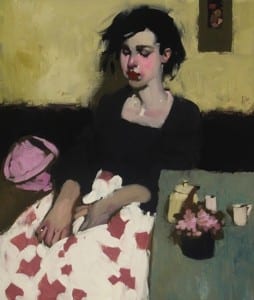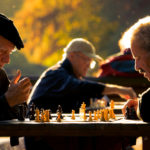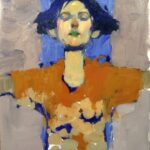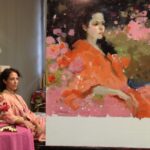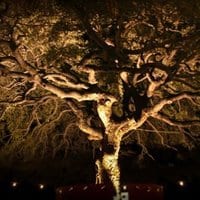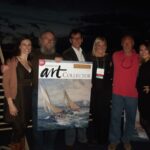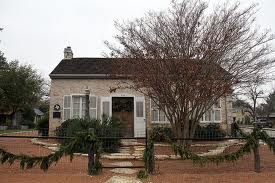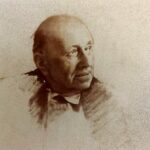
The 1960’s did not give a young student many options, so I took the logical, affordable one. For me, growing as an artist followed the path of trial and error with some influential and valuable guidance along the way. Mainly, however, I feel I am mostly self-taught. At one point in my career, I probably considered that a badge of honor, but not anymore. Now I consider it a shame and a powerful condemnation of the sad state of art education during my formative years.
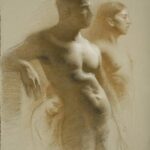
There are now art schools around the world, many in this country, that are intent on researching and restoring the teaching methods of old that produced the world’s greatest artists.
We really owe a great deal of gratitude to those who are dedicating themselves to teaching these traditional methods, for we’re already seeing the phenomenal results of such training among many of our younger artists.

In the interview that follows, my hope is that we gain a deeper understanding of what some are calling “Classical Realism”. What is it and what are it’s roots? What distinguishes classical training from other types of art instruction, and why is it important?
I think you will find this three-part interview very enlightening.
Michael John Angel

Juliette Aristides

David Hardy
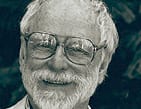
Interview
“Classically trained” and “classical realism” are terms often bandied about by fine artists today. What exactly is meant by those terms?
 Aristides: Classical Realism was a term coined by Richard Lack. On the surface it looks like a contradiction of terms. Realism often refers to an unfiltered view of everyday life. Classism works within a tradition striving for an ideal between nature and design. I imagine the term Classical Realism reflects the striving of an artist to see and express the ideal in life. I love this definition of classism from an unlikely source, the Romantic artist, Eugene Delacroix: “I would readily apply the term “classical” to all well-ordered works which satisfy the mind, not only by an accurate, noble, or lively rendering of sentiments and objects, but also by their unity and logical arrangements. In short, by all those qualities which enhance the impression by creating a final simplicity.”
Aristides: Classical Realism was a term coined by Richard Lack. On the surface it looks like a contradiction of terms. Realism often refers to an unfiltered view of everyday life. Classism works within a tradition striving for an ideal between nature and design. I imagine the term Classical Realism reflects the striving of an artist to see and express the ideal in life. I love this definition of classism from an unlikely source, the Romantic artist, Eugene Delacroix: “I would readily apply the term “classical” to all well-ordered works which satisfy the mind, not only by an accurate, noble, or lively rendering of sentiments and objects, but also by their unity and logical arrangements. In short, by all those qualities which enhance the impression by creating a final simplicity.”
![]() Hardy: The terms “Classically trained” and “Classical Realism” vary in meaning in the art community because there is a wide range of understanding and cultural sophistication amongst some of those using these terms. I choose to name my atelier the Atelier School of Classical Realism for two reasons: (1) Atelier because I have adapted some of the teaching approaches and concepts popular in Paris in the 19th century. Atelier (French for ‘studio’) studies brought a limited (small) group of students together to learn from a respected master. (2) I firmly believe, with but a few later exceptions, that the major Baroque artists brought realism to a level rarely touched since. Because of this, I have made the effort to become very involved with Baroque technology. When I think of classical realism, I think of Old Master baroque artists, such as Rembrandt, Vermeer, Hals, Reubens, Van Dyke, Carravagio and Velasquez.
Hardy: The terms “Classically trained” and “Classical Realism” vary in meaning in the art community because there is a wide range of understanding and cultural sophistication amongst some of those using these terms. I choose to name my atelier the Atelier School of Classical Realism for two reasons: (1) Atelier because I have adapted some of the teaching approaches and concepts popular in Paris in the 19th century. Atelier (French for ‘studio’) studies brought a limited (small) group of students together to learn from a respected master. (2) I firmly believe, with but a few later exceptions, that the major Baroque artists brought realism to a level rarely touched since. Because of this, I have made the effort to become very involved with Baroque technology. When I think of classical realism, I think of Old Master baroque artists, such as Rembrandt, Vermeer, Hals, Reubens, Van Dyke, Carravagio and Velasquez.
 Angel: I hate to start off by being pedantic, but “Classical Realism” is actually a misnomer: the adjective Classical specifically refers to things from the Classical period in Greece (c.480 to 323 BC), and classical (lower-case C) refers more generally to things to do with Greece and ancient Rome. Classic Realism is better, or Traditional Realism. A classic shoe is just that, whereas a classical shoe is a sandal. The only classical painting that we have is vase painting. Realism is a difficult word, too, implying as it does things that we see in reality, i.e. everyday genre painting. This would exclude all symbolic allegory, including mythology, Christian or pagan. It also tends to exclude Conceptualism, but more about this later. I prefer Representational Painting (or Sculpture, of course), but it’s something of a mouthful. (Another much misused word is figurative. It actually means representational: a still life or a landscape are figurative, as are figural works such as nudes and portraits.) Sorry to go on, but you did ask!!
Angel: I hate to start off by being pedantic, but “Classical Realism” is actually a misnomer: the adjective Classical specifically refers to things from the Classical period in Greece (c.480 to 323 BC), and classical (lower-case C) refers more generally to things to do with Greece and ancient Rome. Classic Realism is better, or Traditional Realism. A classic shoe is just that, whereas a classical shoe is a sandal. The only classical painting that we have is vase painting. Realism is a difficult word, too, implying as it does things that we see in reality, i.e. everyday genre painting. This would exclude all symbolic allegory, including mythology, Christian or pagan. It also tends to exclude Conceptualism, but more about this later. I prefer Representational Painting (or Sculpture, of course), but it’s something of a mouthful. (Another much misused word is figurative. It actually means representational: a still life or a landscape are figurative, as are figural works such as nudes and portraits.) Sorry to go on, but you did ask!!
What characteristics are synonymous among all things classical?
 Aristides: It was said very well by the artist and author Kenyon Cox, in his book The Classic point of view (1911): “The Classic Spirit is the disinterested search for perfection; it is the love of clearness and reasonableness and self-control; it is, above all, the love of permanence and of continuity. It asks of a work of art, not that it shall be novel or effective, but that it shall be fine and noble. It seeks not merely to express individuality or emotion but to express disciplined emotion and individuality restrained by law. It strives for the essential rather than the accidental, the eternal rather than the momentary – loves impersonality more than personality, and feels more power in the orderly succession of the hours and the seasons than in the violence of earthquake or of storm.”
Aristides: It was said very well by the artist and author Kenyon Cox, in his book The Classic point of view (1911): “The Classic Spirit is the disinterested search for perfection; it is the love of clearness and reasonableness and self-control; it is, above all, the love of permanence and of continuity. It asks of a work of art, not that it shall be novel or effective, but that it shall be fine and noble. It seeks not merely to express individuality or emotion but to express disciplined emotion and individuality restrained by law. It strives for the essential rather than the accidental, the eternal rather than the momentary – loves impersonality more than personality, and feels more power in the orderly succession of the hours and the seasons than in the violence of earthquake or of storm.”
![]() Hardy: When I think of classical things, I think of search for truth, search for the ultimate in ideals, plus clarity and accessibility.
Hardy: When I think of classical things, I think of search for truth, search for the ultimate in ideals, plus clarity and accessibility.
Why do we credit and accept the Greeks as establishing the canons of beauty?
 Aristides: Greek art, in the Classical period, reached a remarkable balance between adherence to proportional cannons and naturalism. The Greeks moved away from static proportional systems, identifying and formalizing the attributes of beauty from nature. When looking at images from an art history timeline, you can see the Greeks so surpassed their predecessors in sophistication that the culture almost appears to spring up out of thin air.
Aristides: Greek art, in the Classical period, reached a remarkable balance between adherence to proportional cannons and naturalism. The Greeks moved away from static proportional systems, identifying and formalizing the attributes of beauty from nature. When looking at images from an art history timeline, you can see the Greeks so surpassed their predecessors in sophistication that the culture almost appears to spring up out of thin air.
 Hardy: Because they were there “firstest with the mostest”.
Hardy: Because they were there “firstest with the mostest”.
Why the fascination with ancient Greece and Rome?
 Aristides: In his book Civilization, Kenneth Clark wrote that “Western Europe had inherited an ideal invented in Greece in the 5th century B.C which was so satisfying to the mind and eye that it lasted practically unchanged for over six-hundred years”. During my travels this summer it is easy to see its powerful influence in America – in old city Philadelphia. It not only affected Europe, but when the New World was being shaped our founding fathers looked all the way back to Greco-Roman times, not only as a model for democracy, but also to their arts and architecture. It was the high point in philosophy, art, architecture, civic life, mathematics, etc and became the basis for Western Culture. The ancient Greeks were seeking after permanence and a perfect balance of reason, beauty and justice. They were trying to create a model civilization, not just copying what came before them…but innovating. Perhaps we are drawn to the best of those ideals.
Aristides: In his book Civilization, Kenneth Clark wrote that “Western Europe had inherited an ideal invented in Greece in the 5th century B.C which was so satisfying to the mind and eye that it lasted practically unchanged for over six-hundred years”. During my travels this summer it is easy to see its powerful influence in America – in old city Philadelphia. It not only affected Europe, but when the New World was being shaped our founding fathers looked all the way back to Greco-Roman times, not only as a model for democracy, but also to their arts and architecture. It was the high point in philosophy, art, architecture, civic life, mathematics, etc and became the basis for Western Culture. The ancient Greeks were seeking after permanence and a perfect balance of reason, beauty and justice. They were trying to create a model civilization, not just copying what came before them…but innovating. Perhaps we are drawn to the best of those ideals.
![]() Hardy: Because most of the ideals and structure of western society today were fermented and given birth in ancient Greece and Rome.
Hardy: Because most of the ideals and structure of western society today were fermented and given birth in ancient Greece and Rome.
Is the fascination with Greek and Roman antiquity concerned mainly with appearances or does it also extend to the philosophies of that time?
![]() Hardy: The almost exclusive survival of Greek art has been their statues. Greek statuary was an expression of their belief that all of their pantheon of gods existed as super perfect versions of humans…more handsome or beautiful, perfectly proportioned, more graceful.
Hardy: The almost exclusive survival of Greek art has been their statues. Greek statuary was an expression of their belief that all of their pantheon of gods existed as super perfect versions of humans…more handsome or beautiful, perfectly proportioned, more graceful.
 Aristides: Today, I don’t know that many artists are actually influenced by classical art, and architecture in the strict meaning of the word. Rather, I think there is a desire to understand artistic systems from the past so we can create the best art possible for the times in which we live. I think we are in such a disposable culture, the desire to make something that lasts, that attempts permanence, is compelling. We look back and are inspired to try a little harder.
Aristides: Today, I don’t know that many artists are actually influenced by classical art, and architecture in the strict meaning of the word. Rather, I think there is a desire to understand artistic systems from the past so we can create the best art possible for the times in which we live. I think we are in such a disposable culture, the desire to make something that lasts, that attempts permanence, is compelling. We look back and are inspired to try a little harder.
Mr. Angel has combined these last four questions into the following response:
 Angel: The sculpture of ancient Greece and Rome transcends everyday reality. We feel as though we are looking through the specific – the model, the subject – into the eternal, and this is why it haunts us. How do they accomplish this? All representational art should be a combination of the empirical and the conceptual. Modern ateliers teach the basic geometrical forms – at Angel’s, we teach that there are four pure ones: the cylinder, the egg, the block, and the pyramid, plus the various hybrids between these – and how to render these, illusionistically, on a two-dimensional surface. The ancients stressed these pure forms, modifying them empirically just enough to conjure the appearance of a human, but they leave us with the sense of the Eternal, the perennial flux. They combined this with a profound grasp of gesture, itself a conceptual thing, and of grace, which they created by the use of flow-through lines, rhyming forms and proportion. A great deal of our modern Realism deals only with the empirical, thinking that this is what the masters did; however, if I were to show you a reproduction of a Caravaggio (or a Ribera, or a van Dyck…) and tell you that this is a photo of some models posing, you wouldn’t believe me for a minute. Caravaggio, with or without mirror projections, has changed something; he has conceptualized (simplified and purified) the forms to make them more powerful and, ironically enough, more convincing.
Angel: The sculpture of ancient Greece and Rome transcends everyday reality. We feel as though we are looking through the specific – the model, the subject – into the eternal, and this is why it haunts us. How do they accomplish this? All representational art should be a combination of the empirical and the conceptual. Modern ateliers teach the basic geometrical forms – at Angel’s, we teach that there are four pure ones: the cylinder, the egg, the block, and the pyramid, plus the various hybrids between these – and how to render these, illusionistically, on a two-dimensional surface. The ancients stressed these pure forms, modifying them empirically just enough to conjure the appearance of a human, but they leave us with the sense of the Eternal, the perennial flux. They combined this with a profound grasp of gesture, itself a conceptual thing, and of grace, which they created by the use of flow-through lines, rhyming forms and proportion. A great deal of our modern Realism deals only with the empirical, thinking that this is what the masters did; however, if I were to show you a reproduction of a Caravaggio (or a Ribera, or a van Dyck…) and tell you that this is a photo of some models posing, you wouldn’t believe me for a minute. Caravaggio, with or without mirror projections, has changed something; he has conceptualized (simplified and purified) the forms to make them more powerful and, ironically enough, more convincing.

